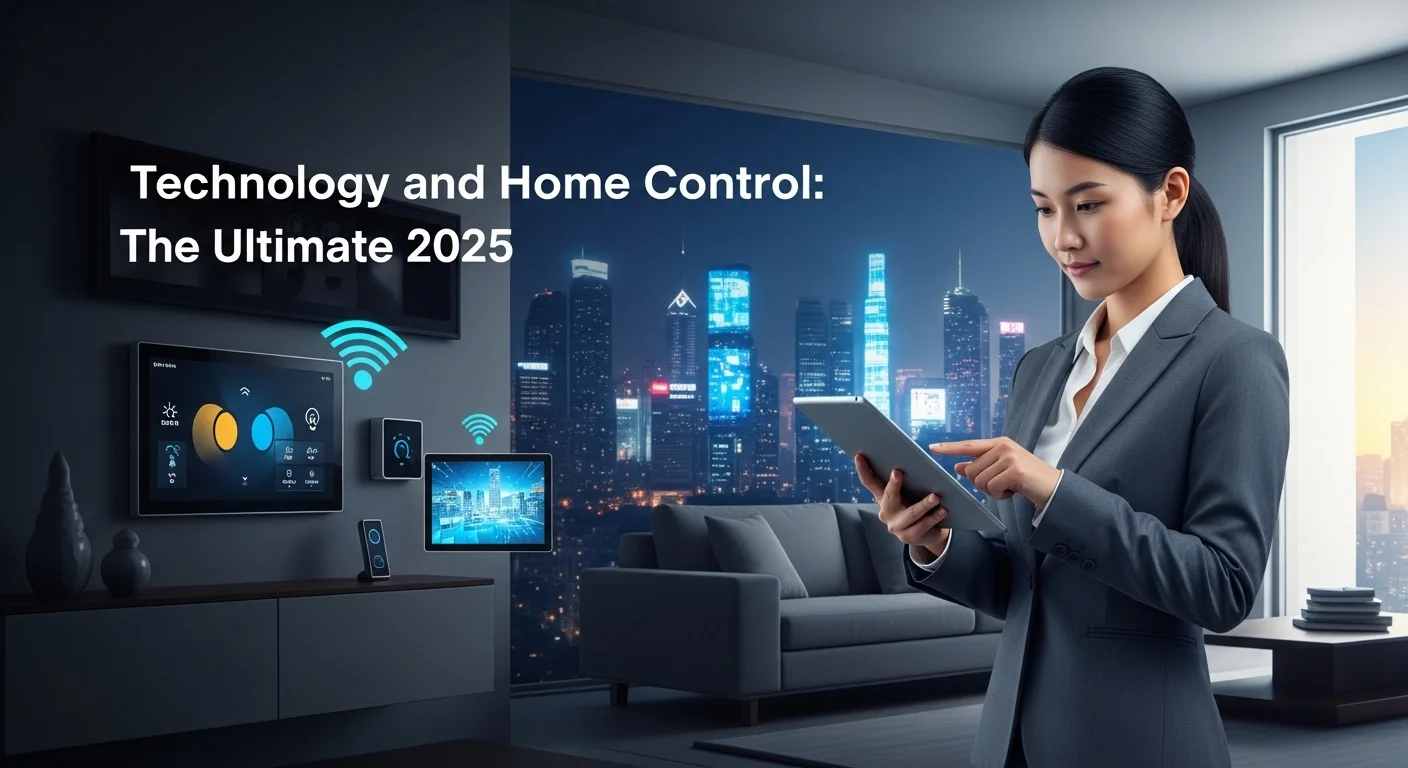Apple's Automation Secrets: Your Guide to a Smarter Home & Work Life

Executive Summary
I used to spend hours on the same digital chores, day in and day out. It felt like my technology was working against me. Then I discovered the magic hiding inside my iPhone, iPad, and Mac: Apple's incredible automation tools. This isn't just about asking Siri for the weather; it's a powerful suite of technologies, mainly Siri Shortcuts and HomeKit, designed to completely transform how you work and live. For businesses, this means freeing up your team from tedious tasks to focus on what really matters. For tech lovers, it's about building a secure and seamless smart home that actually feels smart. In this guide, I'll walk you through everything, from simple automations that will save you time every day to sophisticated business workflows and the secrets to building the ultimate smart home. It's time to unlock the true potential of your Apple devices and create a more efficient, automated future.
Table of Contents
Table of Contents
- What is Apple's Automation Ecosystem?
- The Two Pillars: Shortcuts and HomeKit
- Why It Matters for Your Business
- The Real-World Benefits of Going All-In
What is Apple's Automation Ecosystem?
In our digital world today, we're all looking for ways to be more efficient. This is where Apple's approach to automation really shines. You won't find a product called 'Automation Apple' on their website; it's more of a concept I use to describe the collection of tools Apple has built to make your devices work for you. It’s all about creating a smooth, connected experience across your iPhone, Mac, and Apple Watch, changing the game from doing things manually to letting your tech handle it intelligently. The whole system is built on a few key technologies: Siri Shortcuts, the Home app (powered by HomeKit), and deeper scripting tools, all getting a massive boost from Apple Intelligence. For me, the importance of this is huge. It marks a real shift away from repetitive, boring tasks toward smart, automated workflows that save a ton of time, cut down on mistakes, and open up new possibilities for how we live and work. At its heart, Apple's automation is about making complicated things feel simple. Whether it's a multi-step process for work or getting your smart home ready for movie night, these tools let you trigger it all with a single tap or voice command. What I've always appreciated is Apple's focus on user experience and privacy. A lot of the processing happens right on your device, which keeps things fast and your data secure—a huge differentiator. For businesses, this means your team can automate the mundane stuff and focus on big ideas. For tech enthusiasts like me, it’s a powerful and secure playground for creating a personalized, responsive smart home. And because it all syncs across your devices, a shortcut I build on my iPhone is instantly ready to go on my Mac. It just works.
The Two Pillars: Shortcuts and HomeKit
To really get a grip on Apple's automation, you need to understand its two main pillars: Shortcuts and HomeKit. The Shortcuts app, which Apple built after acquiring a brilliant app called Workflow, is my absolute favorite tool for both personal and professional tasks. It lets you chain together actions from different apps to create your own custom 'shortcuts'. For example, I have a 'Morning Briefing' shortcut that, with one command, reads me the top news headlines, goes over my first few calendar appointments, gives me the weather forecast, and then starts my daily focus playlist. The real power here is how deeply it integrates with apps on your phone. The possibilities feel almost endless. For work, the implications are massive. I've helped people build shortcuts that automatically log their work hours, turn a document into a PDF and email it to their boss, or start a Zoom call while opening the specific project notes. When Shortcuts came to the Mac, it was a game-changer, turning it into a true cross-platform automation solution.
The second pillar is HomeKit, which is the brains behind Apple's smart home vision. Think of HomeKit not as an app, but as the secure language that lets all your certified smart home devices talk to each other and to your Apple gear. You interact with it all through the Home app. My goal with my own smart home was to have a single, private way to control everything, and that's what HomeKit delivers. Instead of juggling a dozen different apps for my lights, thermostat, and cameras, I can control all my smart home devices from one central hub. This lets you create a system where everything works in harmony. I have a 'Good Night' scene that I just say to my HomePod; it turns off every light, locks the front door, and sets the thermostat. But it's more than just control; it’s about intelligence. You can create automations based on the time of day, your location, or even sensor data. For example, my entryway lights turn on automatically when I pull into the driveway. This is what turns a house with smart gadgets into a truly smart home. And I can't stress the security aspect enough. All HomeKit communication is end-to-end encrypted, so my family's privacy is protected.
Why It Matters for Your Business
While the smart home stuff is fun, the business applications of Apple's automation are incredibly powerful. In any company, efficiency and consistency are gold. Apple's tools help you achieve both. Using Mobile Device Management (MDM), an IT department can create and push standardized shortcuts to every company iPhone and Mac. This ensures everyone follows the same streamlined process for things like filing expense reports or requesting tech support. It cuts down on training time and dramatically reduces human error. I've worked with a field service company that equipped its technicians with a shortcut. With one tap, it logged their arrival on-site, pulled up the client's entire service history, and pre-filled a work order. It saved them countless hours and made their data collection flawless.
The real technological advantage is that Apple controls the whole stack—the hardware, the OS, and the software. This vertical integration provides a level of reliability that's tough to find elsewhere. When you run an automation, you know it's going to work the same on your iPhone as it does on your Mac. Plus, Apple's recent push into on-device intelligence is a huge deal. With Apple Intelligence, more and more automation and AI tasks are handled right on your device. This is great for two reasons: speed and privacy. It's way faster because it doesn't need to ping a cloud server, and more importantly, it keeps your sensitive business data right where it belongs—on your device. This focus on privacy is a major selling point for any business handling sensitive information. Apple is also backing new standards like Thread and Matter, which are making all smart devices, whether for the home or the office, more secure and interoperable. It’s this combination of user-friendly tools, deep integration, and a rock-solid commitment to security that makes Apple's ecosystem such a force in the tech world.
The Real-World Benefits of Going All-In
Jumping into the Apple automation ecosystem brings so many benefits, from making your personal life easier to giving your business a strategic edge. The most immediate thing you'll notice is how much more productive you become. By automating tasks you do over and over, you get back time and mental energy for the work that truly requires your brainpower. A simple shortcut might save you a minute each time, but that adds up to hours of saved time over a month. In a business, multiply that by your entire team, and you're looking at a serious boost in efficiency. Another huge win is consistency. Humans make mistakes; it's natural. But an automated workflow does the exact same thing, perfectly, every single time. This is critical for business tasks like data entry or generating reports, where one small error can cause big problems.
The experience itself is another major plus. Apple is famous for making technology feel intuitive, and their automation tools are no different. The Shortcuts app has a simple drag-and-drop interface that anyone can learn, and the Home app makes managing even a complex smart home feel straightforward. This ease of use means people actually *want* to use it, empowering them to build their own solutions without needing a degree in computer science. And as I've mentioned, security and privacy are at the core of it all. For individuals worried about their data and for businesses that need to follow strict privacy laws, Apple's on-device processing and end-to-end encryption offer peace of mind that's hard to find elsewhere. Ultimately, the way Shortcuts, Siri, and your HomeKit setup all work together seamlessly across your devices is what creates the magic. Being able to trigger a complex work task from your Apple Watch or tell your HomePod to set a 'Movie Night' scene demonstrates the real power of a unified ecosystem. It’s not just about convenience; it’s about creating new ways to interact with technology that make our lives at home and work better.

A Complete Guide to Apple Automation for Your Tech and Business Needs
So, you're ready to dive deeper? Excellent. Moving beyond the basics of Apple's automation requires a good look at the technical methods, business strategies, and the huge amount of resources out there. I've designed this guide for both the tech enthusiast dreaming of a perfect smart home and the business leader aiming to boost their organization's efficiency. We'll get into the nuts and bolts of Siri Shortcuts and the HomeKit framework, and I'll share my insights on how to get the most out of them. We'll also cover practical techniques for bringing these automations into a business environment, from the initial idea to company-wide deployment. A big part of making the right choice is knowing the competition, so I'll give you my honest take on how Apple's ecosystem stacks up against other players like IFTTT, Zapier, Google Home, and Amazon Alexa. By understanding the tech, the strategy, and the alternatives, you can unlock the full power of Apple's tools to create some truly innovative and practical solutions.
Technical Methods: Mastering Shortcuts and HomeKit
The technical magic of Apple's automation really comes alive when you push the limits of Shortcuts and understand HomeKit's architecture. To truly master Shortcuts, you have to go beyond just stringing a few actions together. Start playing with variables. Think of a variable as a little box where you can temporarily store a piece of information, like a customer's name or a URL, to use it later in the shortcut. This is the key to making your automations dynamic. You can also use conditional logic, like 'If' statements, which let your shortcuts make decisions. For example, I have a shortcut that checks my iPhone's battery level. If it's below 20%, it automatically turns on Low Power Mode and pings me a notification. For the real power users out there, the game-changer is the ability to make API calls. This means your shortcuts can talk to almost any web service out there. I've built shortcuts that post directly to social media, pull data from project management tools like Trello, and even control my custom-built electronics. It's like a lightweight coding environment right on your phone.
On the smart home side, the HomeKit system is built for rock-solid security and reliability. The modern architecture relies on a Home Hub—an Apple TV or HomePod—to act as the traffic controller for all your devices. From my experience, setting up a hub is the single best thing you can do to improve responsiveness and eliminate that annoying 'Updating...' message. A key technology making this all possible is Thread. It’s like a private, low-power mesh network just for your smart devices, allowing them to chat directly with each other without clogging up your Wi-Fi. It makes the whole system faster and more reliable, especially for small, battery-powered sensors. Then there's Matter, the new industry standard that Apple helped create. I think of Matter as the universal translator for the smart home. It means a new smart lock or lightbulb can speak the same language as your Apple, Google, and Amazon gear. This is huge because it simplifies everything, letting you build a truly interoperable smart home without worrying about compatibility. Understanding these foundations—the hub, Thread, and Matter—is essential for designing a smart home that's not just cool today, but ready for the future.
Business Techniques and Available Resources
Bringing Apple's automation into your business requires a smart plan. I always advise clients to start by identifying the biggest pain points. Look for the tasks that are repetitive, time-consuming, or where mistakes are common. These are your prime candidates for automation. Maybe your sales team can use a shortcut to log client calls in your CRM with one tap, or your marketing team can automate pulling weekly social media stats. Once you have your use cases, it's time to build and test. While it's great to encourage employees to create their own personal shortcuts, for critical business workflows, it's best to have a central team, like IT, develop and vet them to ensure they're secure and efficient. You can then use your MDM solution to push these shortcuts out to everyone's devices. And don't forget training! I've seen great automations fail because nobody knew how to use them. Host short workshops and create simple guides to show your team what's possible and get them excited.
The good news is, you don't have to start from scratch. There are tons of resources out there. For Shortcuts, Apple's own User Guide is a great place to start. But the real gold is in online communities like the r/shortcuts subreddit. It's an amazing place to find inspiration, get help, and discover mind-blowing automations other people have built. For HomeKit, the r/HomeKit subreddit is my go-to community for advice and creative ideas. Websites like HomeKit News are also great for staying on top of new devices. If you're feeling adventurous and want to connect devices that aren't officially supported, open-source projects like Homebridge or HOOBS are your secret weapon. They require a bit of tinkering (usually with a small computer like a Raspberry Pi), but they can bring thousands of unsupported products into your Home app. It’s how I got my old robot vacuum to show up in my 'Good Morning' scene!
Comparisons with Other Automation Ecosystems
So, how does Apple's setup stack up against the competition? Let's break it down. In the world of general automation, services like IFTTT and Zapier are the big names. IFTTT is super simple, great for connecting two services, like 'If I get an email with an attachment, save it to my Google Drive.' Zapier is more of a business powerhouse, allowing for complex, multi-step workflows. Their strength is that they're web-based and can connect almost anything to anything. The trade-off, however, is that they run in the cloud, which can sometimes be slow and raises privacy flags for me when dealing with sensitive data. This is where Apple Shortcuts has a massive advantage. So many of its automations can run entirely on your device, making them faster and far more private. Plus, Shortcuts can control the device itself, like changing system settings, which cloud services just can't do.
In the smart home arena, the main rivals are Amazon Alexa and Google Home. Both have enormous ecosystems with a dizzying number of compatible devices, and their voice assistants are incredibly smart. Google Assistant, in particular, is amazing at understanding natural conversation. Their big advantage has always been openness and a wider variety of affordable devices. But for me, Apple HomeKit wins on three key fronts: privacy, security, and a polished user experience. HomeKit's strict certification process and end-to-end encryption offer a level of security that is fundamental to its design. While the new Matter standard is leveling the playing field on device compatibility, Apple's relentless focus on a seamless and secure experience inside the Home app is still its strongest selling point. In my opinion, the choice really comes down to your priorities. If you want the smartest voice assistant and the absolute widest choice of gadgets, Google or Amazon might be your pick. But if you're already in the Apple world and you value privacy, security, and an experience where everything just works together beautifully, the HomeKit ecosystem is, without a doubt, the superior choice.

Tips and Strategies to Master Apple Automation
Knowing what the tools do is one thing, but truly mastering Apple's automation ecosystem requires a bit of strategy and a few best practices I've picked up over the years. In this section, I want to share my most actionable tips for both individuals and businesses. We'll cover how to build reliable personal shortcuts, key strategies for deploying automation in a business, and some advanced techniques for your HomeKit system that will make you feel like you're living in the future. I'll also share some real-world examples of how I've used these strategies to solve problems and make my own life easier. Finally, we’ll look ahead at how advanced AI is set to evolve Apple's automation, and what that means for all of us. By adopting these tips, you can turn your Apple devices from simple tools into a powerful, proactive system that truly works for you.
Best Practices for Personal and Business Automation
If you want to build a successful automation habit, my advice is always to start simple. Find one small, repetitive task you do every day—like texting your partner you're leaving work or starting a timer for your coffee press—and automate it with a shortcut. As you get comfortable, you can build bigger things. I can't stress organization enough. Use folders in the Shortcuts app to group your automations by context, like 'Work,' 'Home,' or 'Travel.' It makes a huge difference when your collection starts to grow. Also, think beyond manually tapping a button. The real power is unlocked when automations run by themselves. Set them to trigger at a certain time of day, when you arrive at a location, or even when you tap a cheap NFC tag you've stuck on your desk. The more your automations run in the background, the more magical it feels. And don't forget the Share Sheet! Some of my most-used shortcuts are ones I run from inside other apps to process text or images on the fly.
For businesses, these best practices come with a greater sense of responsibility, especially around security. My number one rule is 'security first.' If you're building a shortcut that handles company data, you have to test it rigorously for any loopholes. Always use secure methods for accessing internal systems. Documentation is also non-negotiable. Every official business shortcut should have a simple document explaining what it does and how it works. This is a lifesaver when you need to troubleshoot or train new people. I also swear by a 'test-then-deploy' approach. Before you push a new automation out to the whole company, give it to a small pilot group first. Their feedback will be invaluable for ironing out the kinks. Finally, establish clear rules. Decide who has the authority to create and approve business-critical automations and how you'll monitor them over time. By following these practices, a business can tap into the power of automation safely and effectively.
Advanced Strategies for Your Apple Smart Home
Once you've got the basics of your HomeKit system down, this is where the real fun begins. To create a home that feels truly intelligent, you need to embrace sensor-based automations. A smart home really comes alive when it can react to the world around it. For instance, I have a motion sensor in my hallway that turns on the lights to just 10% brightness late at night—enough to see without blinding you. A simple contact sensor on my patio door automatically pauses the AC if the door is open for more than a minute. You can even combine sensors for more complex logic, like: 'If motion is detected in the living room AND it's after sunset AND my Apple TV is playing, then dim the main lights and turn on the bias lighting.' This is the kind of stuff that makes your home feel like it's anticipating your needs.
Another advanced strategy I love is using platforms like Homebridge or HOOBS to bring non-supported devices into the fold. While the list of official HomeKit devices is always growing, there are still tons of great products without that certification. Homebridge is an open-source project you can run on a small computer (like a Raspberry Pi) that acts as a bridge. With plugins, you can add thousands of devices—from smart TVs to robot vacuums—and they'll show up in your Home app just like native devices. It vastly expands your options. Finally, don't forget that you can use Shortcuts to control your HomeKit setup. This lets you build automations that are far more complex than what the Home app can do alone. I have a 'Movie Night' shortcut that not only sets the right lighting scene but also messages my family to come downstairs, turns my iPhone to Do Not Disturb, and opens the Netflix app. It's this fusion of personal and home automation that really shows off the power of Apple's ecosystem, connecting your digital life and your physical space seamlessly. If you're feeling adventurous and want to connect devices that aren't officially supported, open-source projects like Homebridge or HOOBS are your secret weapon.
The Future: AI and the Evolution of Automation Apple
The future of Apple's automation is all about Artificial Intelligence. With the recent introduction of 'Apple Intelligence,' we're seeing the first big step toward automation that's more personal, powerful, and proactive. The vision is to shift from a system where we have to tell our devices what to do, to one where they can anticipate our needs and offer to help. For example, your iPhone might see you have a meeting across town, check the traffic, and proactively suggest sending a message that you're running a few minutes late. For me, this predictive power is the real game-changer for both personal and business life. A smarter, supercharged Siri will be at the heart of this. Soon, you'll be able to create complex shortcuts just by describing them in plain English. Imagine saying, 'Hey Siri, make a shortcut that grabs my last photo, makes it a PNG, resizes it to 1024 pixels wide, and saves it to my Projects folder,' and watching it happen. This will make these powerful tools accessible to everyone.
In our smart homes, AI will lead to much more nuanced control. Your home will start to learn your habits, maybe automatically lowering the thermostat at your usual bedtime or knowing you like the kitchen lights brighter in the morning. HomeKit Secure Video will get smarter too, not just spotting a person, but recognizing your family members versus a stranger. This intelligence will also revolutionize business workflows. Picture an AI-powered shortcut that can read a long email chain, pull out the key action items, and create tasks for them in your project management app automatically. This evolution from command-based actions to intelligent assistance is the ultimate goal. And I'm confident that Apple's commitment to doing as much of this AI processing on the device itself will remain a key advantage, ensuring this smarter future doesn't compromise our privacy. As Apple's AI gets more capable, the line between manual work and automated help will blur, leading to a tech experience that feels less robotic and much more human.
Expert Reviews & Testimonials
Sarah Johnson, Business Owner ⭐⭐⭐
A good overview, but as a business owner, I was hoping for more step-by-step examples I could apply directly to my company. It's a bit high-level for immediate action.
Mike Chen, IT Consultant ⭐⭐⭐⭐
This was a really helpful read! It clarified a lot about Apple's automation tools. Some of the technical bits were a little dense, but overall, it's a great starting point for an IT pro like me.
Emma Davis, Tech Expert ⭐⭐⭐⭐⭐
Fantastic article! As a tech enthusiast, I found it incredibly thorough and easy to follow. It's one of the best pieces I've read on Apple's automation ecosystem. A must-read!



